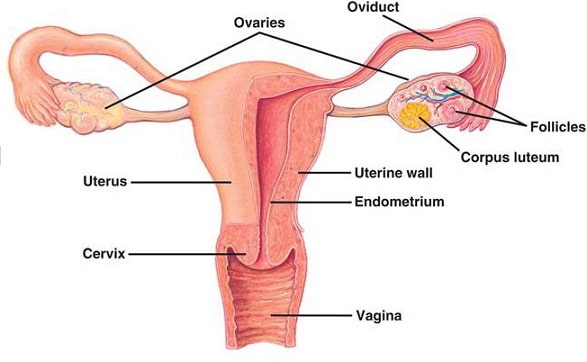Ovarian cysts are the most common type of benign lesions detected by routine ultrasound examination. In most cases, ovarian cysts do not show symptoms that is why cysts go unnoticed throughout the life of a female. A cyst becomes a problem when it increases in size and requires treatment.
For the understanding of the ovarian cyst medical treatment, you need to know about the working of ovaries.
Ovaries and cysts
The ovaries are a pair of tiny, oval-shaped organs in the lower part of a female belly or abdomen, one present at each side of the uterus. Every month, an egg is released from an ovary. This is known as ovulation The ovaries also produce the hormones estrogen and progesterone. These play roles in pregnancy, the menstrual cycle, and breast growth.
An ovarian cyst is a closed fluid-filled sac-like structure that forms on or inside an ovary. An ovarian cyst can develop for different reasons. Most ovarian cysts are harmless and disappear after some time. Cysts may or may not form a tumor. If it results in a tumor, it may be benign or malignant that require surgical removal. Usually, cysts are diagnosed with a physical examination or an ultrasound.
Signs and symptoms of ovarian cysts
In most cases, ovarian cysts are not noticed and disappear without women ever realizing that they had a cyst. When a cyst shows symptoms, pain in the abdomen (tummy) is the most common one. The pain can be caused by rapid growth and stretching, rapturing or internal bleeding of the cyst.
Some other symptoms may also appear such as:
- Breathlessness
- Bloating
- Abdominal swelling
- Indigestion
- Lower back pain
- Urinary urgency and pain while urinating
- Difficult bowel movements
- Unusual bleeding
- Breast pain
- Difficulty getting pregnant
- Pain while having sexual intercourse
Types and causes of ovarian cysts
There are many causes of ovarian cysts, varying from type to type. Depending on the type, ovarian cyst medical treatment is decided.
- Follicular cysts
The most prevalent type is a follicular cyst, which results from the growth of a follicle. A follicle is a sac that contains an egg. Follicular cysts are formed when there is an abnormal follicular growth or during menses, the tube does not open to release the egg. Usually, follicular cysts disappear on their own.
- Corpus luteum cysts
The corpus luteum is an area of tissue within the ovary that occurs after the release of an egg from a follicle. If there are no chances of pregnancy, the corpus luteum usually breaks down and disappears. It sometimes gets filled with blood and forms a cyst on the ovary. Usually, this cyst goes away without causing any symptoms.
- Chocolate cysts
A condition in which cells that form the internal lining of the uterus, grow outside of the uterus in other locations, is known as endometriosis. Commonly endometriosis occurs on the ovary. In such situations, the area of endometrial tissue may bleed over time, resulting in the formation of a blood-filled cyst with red or brown colored contents called an endometrioma, also known as a chocolate cyst.
- Polycystic ovarian syndrome
The condition known as a polycystic ovarian syndrome (PCOS) is common among women. It involves the presence of multiple small cysts within both ovaries. PCOS is attributed to the number of hormonal problems and is the most common cause of infertility in women.
- Dermoid cysts or benign cystic teratomas
Both benign and malignant tumors of the ovary may also be cystic. Sometimes, the tissues of the ovary undergo abnormal growth to form other body tissues such as hair or teeth. Cysts having these abnormal tissues are basically tumors called dermoid cysts or benign cystic teratomas.
- Tubo-ovarian abscesses
In a few cases, infections occur around or in the ovaries and follicular tubes. Such infection involves pus-filled cystic spaces in, or around the ovary or tubes. These are known as tubo-ovarian abscesses.
Ovarian cyst medical treatment
In the majority of the cases, ovarian cysts disappear in a few months without the need for treatment. Whether you need an ovarian cyst medical treatment depends on:
- the appearance of symptoms
- its size and appearance
- whether you have undergone the menopause. If you are postmenopausal there is a slightly higher risk that you get ovarian cancer
As of now. There is no proper way to prevent the development of an ovarian cyst. Therefore, when a cyst is formed, it is advised to go for the ovarian cyst medical treatment. Ovarian cyst medical treatment helps you to get rid of the cyst completely. For this you need to consult your health care provider, he/she will take you to the appropriate ovarian cyst medical treatment.
- Birth control pills
If the size of the ovarian cyst is not too big and if it is still in its early stages, it can go away without any treatment. Your health care provider might recommend birth control pills to stop ovulation that will reduce the chances of cyst formation. If you are not undergoing the process of ovulation, you will not form cysts. This is the most common type of ovarian cyst medical treatment.
Sometimes, surgery becomes necessary to remove cysts. Cysts that show symptoms or that are large or persistent usually require surgery. Surgical removal is also recommended if there is a doubt of cyst becoming cancerous. The type of surgery depends on the size of the cyst or its appearance on the ultrasound. The different surgical procedures used are:
- Laparoscopy
This procedure involves the insertion of a small device through a small incision in the abdomen region. The device is used to blow gas into the pelvis and allows it to get the view of the pelvic cavity and reproductive organs. The doctor then removes the cyst through minute incisions in the skin. Once the cyst is removed, the cuts are closed using dissolvable stitches.
A laparoscopy is a preferred surgical procedure because it induces less pain and has a quicker recovery time. Most patients are allowed to go home on the same day or the following day.
- Laparotomy
This ovarian cyst medical treatment involves the insertion of a small device through a single large cut into the abdomen region. The cyst is then tested for cancer. If it is cancer, the surgeon is going to remove one or both ovaries, some lymph nodes, the uterus, and omentum (fatty tissues). Staples or stitches are used to close the incision. After the procedure, patients are advised to stay in the hospital for a few days.
After surgery
Recovery time after surgery is different for different people. After the removal of the ovarian cyst, you are going to feel pain in the abdomen. It gets better in a few days. After a laparoscopy or a laparotomy, it takes around 11- 12 weeks before you can come back to your normal routine.
You might experience the following symptoms after the surgery:
- heavy bleeding
- severe pain in your abdomen
- fever
- dark or stinky vaginal discharge
These symptoms might be a sign of an infection. In this situation, contact your health care provider.
The ideal ovarian cysts medical treatment depends on the cause of the cysts and whether it is showing symptoms or not. The woman’s age, the size of the cyst, and the cyst’s appearance on ultrasound help determine the appropriate ovarian cyst medical treatment.




